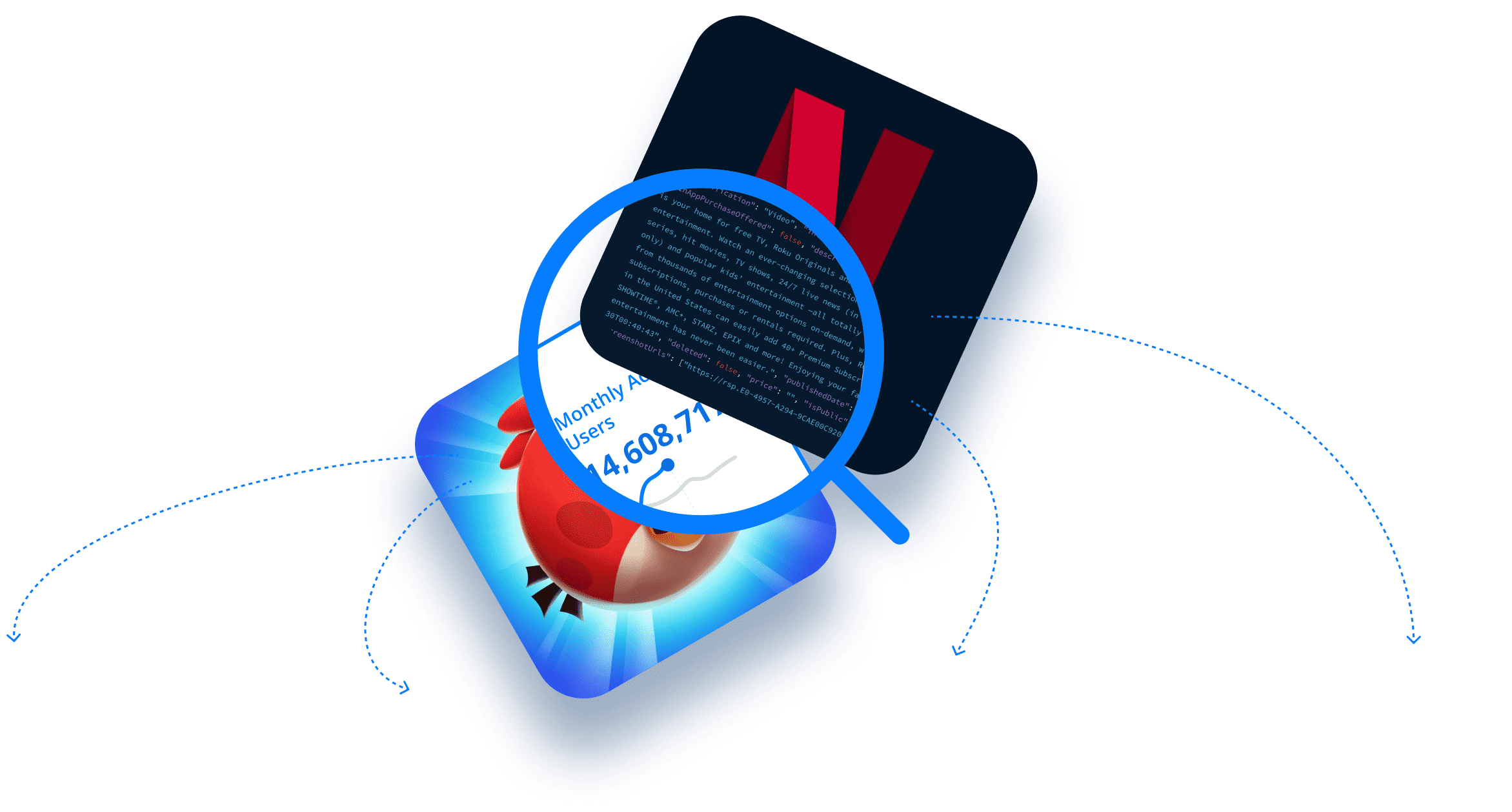If you’re launching a new mobile app, it’s critical that you have an understanding of the mobile app landscape and where you and your competitors fit into it. So, in this article, we walk you through the best strategies and tools for mobile app market research.
Here’s what we cover (click the links below to jump to the relevant sections):
- What Is Market Research?
- Tools for App Market Research
- Market Research Strategies for Mobile Apps
- Identify Your Target Audience
- Conduct Competitor Analysis
- Perform Competitive Benchmarking
- Key Performance Indicators (KPIs)
- Tools for Competitive App Benchmarking and Tracking App KPIs
- Track Your Own Apps
- Benchmark Your Competition
- Discover App Market Trends
What Is Market Research?
First, the basics. Market research is the process of determining the viability of a new product or service in a particular market. In the mobile app space, it is the exercise of determining whether (and how) a mobile app can be successful in app stores like Google Play, the Apple App Store, Amazon Appstore, Tencent MyApp, etc.
Typically, market research leverages information gathering techniques — such as surveys, product tests, focus groups, etc. — to discover ideal or underserved audiences and to identify gaps in the existing market that can be exploited via product differentiation. This can be done in-house or with the help of a third-party that specializes in market research or data collection.
Broadly speaking, information gathered during market research falls into two categories: primary information and secondary information.
Primary information refers to data that you (or a company you hire) collect directly. You can use it to determine whether your app is needed in the market, how to frame your business model, and how to optimize your marketing strategy.
Secondary information, meanwhile, refers to data collected by third-parties — things like demographic and population data from government censuses, industry reports and white papers, data sets, etc. Secondary research enables you to bolster your app and further refine your Go-to-Market strategy.
To summarize, market research seeks to answer two questions:
- Is there a demand for your app?
- If so, what is the best way for you to position it in the market?
Tools for App Market Research
With app market research tools like the 42matters Explorer, 42matters App Watchlist, and our suite of APIs and File Dumps, you’ll have access to a treasure trove of secondary information that can help you answer the questions above.
For example, the Explorer tracks a variety of performance metrics for all published and unpublished apps on Google Play and the Apple App Store. This includes downloads, monthly active users (MAU), ratings, top chart rankings, and other insights relevant to ascertaining market demand. The Explorer will even enable you to:
- See which SDKs apps have integrated or removed.
- Track app changelogs and developer updates.
- Analyze app monetization and localization strategies.
- And more!
In short, app market research tools like ours can help you figure out how your competitors are positioning themselves in the market and how much success they have had.
Market Research Strategies for Mobile Apps
Now, let’s take a look at some strategies for conducting market research in the mobile app space. Once you’ve settled on a product — that is, once you know what sort of app you want to build — you’ll need to…
- Identify Your Target Audience
- Conduct Competitor Analysis
- Perform Competitive Benchmarking
- Identify Your Key Performance Indicators (KPIs)
- Find Tools for Competitive App Benchmarking and Tracking App KPIs
Identify Your Target Audience
A target audience is the specific group of consumers whose attention your app is designed to attract. These audiences can be defined by anything from age to gender, income, geographic location, language, interests, and more.
It’s important to keep in mind that target audiences vary in size and scope and that some niches are more or less broad than others. For example, if you’re building an urban mobility app for Spanish-speaking residents of El Paso, Texas, your target audience will be much smaller than, say, Uber’s. That does not mean, however, that you can’t build successful businesses by targeting smaller audiences. Indeed, many app developers start small and expand their horizons once they’ve worked out the kinks.
In any case, it’s important to define and segment your target audience so that you can make informed strategic decisions. Once you’ve done so, you can plan your app’s creative and branding, UI and UX, country availability and language options, etc. In addition, segmenting your target audience will help you pinpoint the best channels for marketing your app. For instance, if your audience skews young, you can advertise on TikTok, Twitter, and Instagram, whereas, if it was designed for professionals, LinkedIn and Facebook might be better options.
As noted above, your target audience can be defined using a number of different categories. However, the most common tend to be…
- Demographics
- Psychographics (i.e. their activities, interests, and opinions)
- Lifestyle
- Habits (spending, tendencies, etc.)
Focus on these and you will be well on your way to identifying your target audience!
Conduct Competitor Analysis
Next, get a feel for your rivals. Conducting a competitive analysis involves researching your competitors to gain insight into their products, sales strategies, and marketing techniques. In short, it will enable you to deconstruct the recipe of their “secret sauce.”
By identifying what your competitors’ apps do, how they work, what tools and SDKs they use, who their target audiences are, and how frequently they update their apps, you will be able to better position your products and solutions in the market. You’ll be able to implement more robust business strategies, build innovative features and functionalities, integrate usability aspects, and capture market share.
A competitive analysis seeks to reveal…
- Your unique value proposition: This is what makes your app different. It could be a specific functionality, price-point, language option — you name it!
- What your competitors do well: Understanding where your competitors excel is essential for making sure your app stays relevant. Analyze user review sentiment, changes to monthly active users (MAU), download trends, etc. You can use this information to follow their lead or to identify areas where it might be difficult to outcompete them.
- Where your competitors struggle: This is a great way to identify market opportunities and to differentiate your app. As above, review sentiment, MAUs, and downloads are a good place to start.
- Performance benchmarks: It’s important to measure your performance against your competitors. Doing so will help you determine whether your prevailing strategy is up to snuff, while simultaneously giving clearly defined aspirational targets.
Perform Competitive Benchmarking
Competitive benchmarking refers to the practice of researching competitors and industry leaders to identify strategies, practices, and performance metrics that can be used as concrete points of comparison for your business.
Typically, competitive benchmarking involves finding the “best” of any relevant business metric and using it as the gold standard that your company should aim for. It’s a good way of maintaining a competitive edge since it helps you stay up to date with the best market practices.
One of the most straightforward ways to benchmark your app is to identify Key Performance Indicators (KPIs)…
Key Performance Indicators
KPIs are the critical progress indicators that reveal the health of a business, product, or, in this case, app. They provide a guide for strategic and operational improvements, create a tangible basis for planning and decision making, and help companies focus on what matters most.
Importantly, KPIs are quantifiable. They measure a company’s performance against a set of targets, objectives, or peers.
For mobile apps, the most important KPIs tend to be:
- Monthly Active Users (MAU) and Daily Active Users (DAU)
- Downloads (total, monthly, weekly, and daily)
- Top Chart Rankings (overall, country-specific, category-specific)
- User Ratings and Reviews
Tools for Competitive App Benchmarking and Tracking App KPIs
While the 42matters Explorer (as well as our APIs and File Dumps) can be used for competitive benchmarking and KPI tracking, the 42matters App Watchlist was actually designed specifically for these purposes. It’s a dashboard that enables mobile app and game developers, market researchers, and other organizations to track specified iOS and Android apps available on the Apple App Store and Google Play.
The App Watchlist provides insight into estimated country-specific downloads, ratings, top chart rankings, developer updates, integrated SDKs, and more. It can help you:
- Track Your Own Apps
- Benchmark Your Competition
- Discover App Market Trends
Here’s how…
Track Your Own Apps
The App Watchlist makes it easy to track all of your apps across Google Play and the Apple App Store. Everything is available in one, easy-to-use dashboard, meaning you’ll be able to quickly spot changes to important KPIs.
Moreover, since it has country-specific insights, you’ll also be able to see which regions are driving your success. This data can then be used to make informed marketing, sales, and other business decisions.
Benchmark Your Competition
With the App Watchlist, you’ll be able to zero in on what makes your competitors so successful. Not only will you be able to track their market share and estimated downloads, but you’ll also be able to identify a host of factors driving their strategy. This includes:
- Which countries are most critical to their growth.
- What categories or genres they publish to.
- Which SDKs they use and which they have used in the past.
- What users think about their apps.
- Where their apps rank in the top charts.
- And more!
Discover App Market Trends
Finally, the App Watchlist will help you reveal app market trends by enabling you to examine the activity of market leaders and newcomers. You’ll have insight into their go-to-market strategies, including which countries they’re targeting, the changes they’re making to their apps, which SDKs they’re adding or removing, and more.



